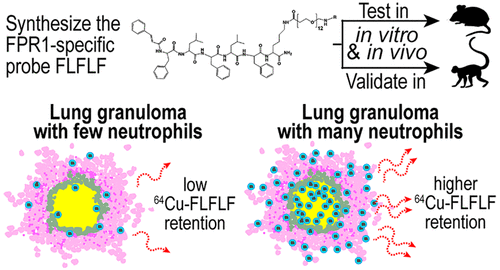当前位置:
X-MOL 学术
›
ACS Infect. Dis.
›
论文详情
Our official English website, www.x-mol.net, welcomes your
feedback! (Note: you will need to create a separate account there.)
Retention of 64Cu-FLFLF, a Formyl Peptide Receptor 1-Specific PET Probe, Correlates with Macrophage and Neutrophil Abundance in Lung Granulomas from Cynomolgus Macaques
ACS Infectious Diseases ( IF 4.0 ) Pub Date : 2021-07-13 , DOI: 10.1021/acsinfecdis.0c00826 Joshua T Mattila 1, 2 , Wissam Beaino 3 , Alexander G White 4 , Lea Nyiranshuti 5 , Pauline Maiello 4 , Jaime Tomko 4 , L James Frye 4 , Daniel Fillmore 4 , Charles A Scanga 2, 4 , Philana Ling Lin 2, 6 , JoAnne L Flynn 2, 5 , Carolyn J Anderson 3, 5, 7, 8, 9
ACS Infectious Diseases ( IF 4.0 ) Pub Date : 2021-07-13 , DOI: 10.1021/acsinfecdis.0c00826 Joshua T Mattila 1, 2 , Wissam Beaino 3 , Alexander G White 4 , Lea Nyiranshuti 5 , Pauline Maiello 4 , Jaime Tomko 4 , L James Frye 4 , Daniel Fillmore 4 , Charles A Scanga 2, 4 , Philana Ling Lin 2, 6 , JoAnne L Flynn 2, 5 , Carolyn J Anderson 3, 5, 7, 8, 9
Affiliation

|
Neutrophilic inflammation correlates with severe tuberculosis (TB), a disease caused by Mycobacterium tuberculosis (Mtb). Granulomas are lesions that form in TB, and a PET probe for following neutrophil recruitment to granulomas could predict disease progression. We tested the formyl peptide receptor 1 (FPR1)-targeting peptide FLFLF in Mtb-infected macaques. Preliminary studies in mice demonstrated specificity for neutrophils. In macaques, 64Cu-FLFLF was retained in lung granulomas and analysis of lung granulomas identified positive correlations between 64Cu-FLFLF and neutrophil and macrophage numbers (R2 = 0.8681 and 0.7643, respectively), and weaker correlations for T cells and B cells (R2 = 0.5744 and 0.5908, respectively), suggesting that multiple cell types drive 64Cu-FLFLF avidity. By PET/CT imaging, we found that granulomas retained 64Cu-FLFLF but with less avidity than the glucose analog 18F-FDG. These studies suggest that neutrophil-specific probes have potential PET/CT applications in TB, but important issues need to be addressed before they can be used in nonhuman primates and humans.
中文翻译:

甲酰基肽受体 1 特异性 PET 探针 64Cu-FLFLF 的保留与食蟹猴肺肉芽肿中巨噬细胞和中性粒细胞的丰度相关
中性粒细胞炎症与严重结核病 (TB) 相关,这是一种由结核分枝杆菌( Mtb ) 引起的疾病。肉芽肿是结核病中形成的病变,中性粒细胞募集到肉芽肿后的 PET 探针可以预测疾病进展。我们在感染Mtb的猕猴中测试了甲酰基肽受体 1 (FPR1) 靶向肽 FLFLF。对小鼠的初步研究证明了对中性粒细胞的特异性。在猕猴中, 64 Cu-FLFLF 保留在肺肉芽肿中,对肺肉芽肿的分析发现64 Cu-FLFLF 与中性粒细胞和巨噬细胞数量呈正相关(分别为 R 2 = 0.8681 和 0.7643),而与 T 细胞和 B 细胞的相关性较弱(R 2分别 = 0.5744 和 0.5908),表明多种细胞类型驱动64 Cu-FLFLF 亲合力。通过 PET/CT 成像,我们发现肉芽肿保留了64 Cu-FLFLF,但亲和力低于葡萄糖类似物18 F-FDG。这些研究表明,中性粒细胞特异性探针在结核病中具有潜在的 PET/CT 应用,但在将其用于非人类灵长类动物和人类之前,需要解决一些重要问题。
更新日期:2021-08-13
中文翻译:

甲酰基肽受体 1 特异性 PET 探针 64Cu-FLFLF 的保留与食蟹猴肺肉芽肿中巨噬细胞和中性粒细胞的丰度相关
中性粒细胞炎症与严重结核病 (TB) 相关,这是一种由结核分枝杆菌( Mtb ) 引起的疾病。肉芽肿是结核病中形成的病变,中性粒细胞募集到肉芽肿后的 PET 探针可以预测疾病进展。我们在感染Mtb的猕猴中测试了甲酰基肽受体 1 (FPR1) 靶向肽 FLFLF。对小鼠的初步研究证明了对中性粒细胞的特异性。在猕猴中, 64 Cu-FLFLF 保留在肺肉芽肿中,对肺肉芽肿的分析发现64 Cu-FLFLF 与中性粒细胞和巨噬细胞数量呈正相关(分别为 R 2 = 0.8681 和 0.7643),而与 T 细胞和 B 细胞的相关性较弱(R 2分别 = 0.5744 和 0.5908),表明多种细胞类型驱动64 Cu-FLFLF 亲合力。通过 PET/CT 成像,我们发现肉芽肿保留了64 Cu-FLFLF,但亲和力低于葡萄糖类似物18 F-FDG。这些研究表明,中性粒细胞特异性探针在结核病中具有潜在的 PET/CT 应用,但在将其用于非人类灵长类动物和人类之前,需要解决一些重要问题。











































 京公网安备 11010802027423号
京公网安备 11010802027423号